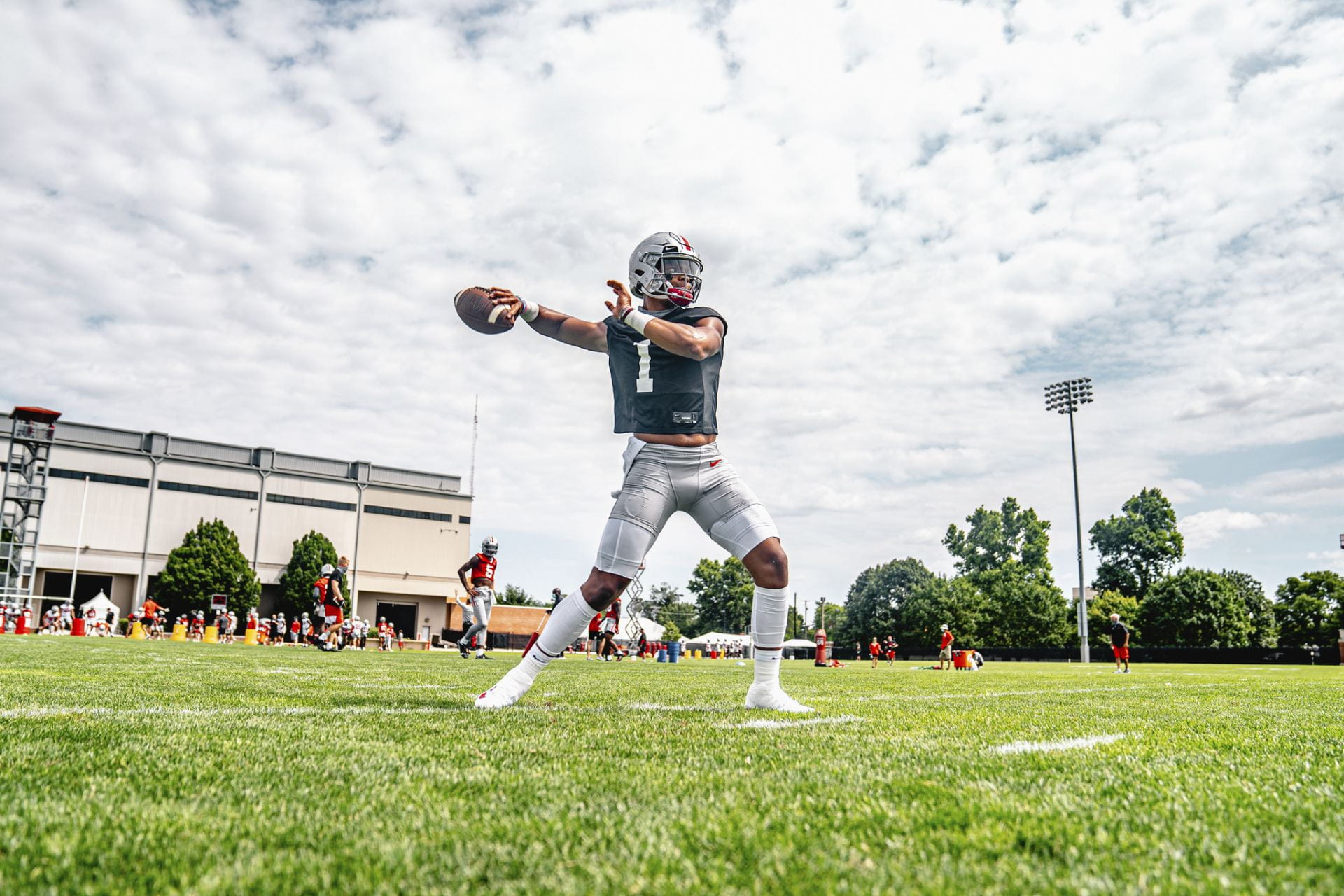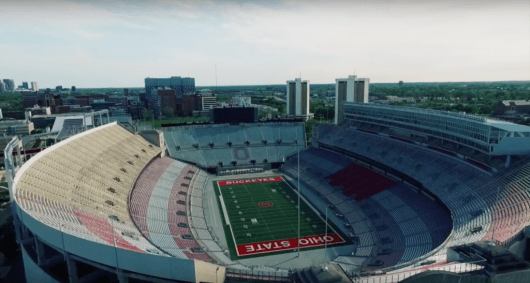
Justin Fields throwing at practice Aug. 6, 2020. | Credit: Courtesy of Ohio State Department of Athletics
Although the Big Ten canceled the 2020 football season Tuesday, the tumultuous offseason that resulted in this decision began in mid-March with the Big Ten’s cancelation of the winter and spring seasons.
March 12 — Big Ten cancels remaining winter and spring sports’ seasons, other Power Five conferences follow suit
Just before action began on the second day of the Big Ten Men’s Basketball Tournament, the Big Ten released a statement that it was canceling all conference and nonconference athletic competitions. This included the waning winter sports seasons along with the recently started spring seasons.
The Big Ten also placed a moratorium on all on- and off-campus recruiting activities for an indefinite period of time. This moratorium would run until July 31.
The Atlantic Coastal Conference joined the Big Ten in postponing the season March 12, while the Big 12 postponed a day later. The Pac-12 announced their cancelation March 14 and the Southeastern Conference was the last to join the Power Fives, waiting to cancel its winter and spring seasons until March 17.
March 13 — Big Ten announces a suspension of organized team activities
Just a day after canceling the winter and spring sports seasons, the Big Ten announced a suspension of all organized team activities.
At this point, Ohio State football had only completed three spring practices. With this announcement, the Buckeyes were no longer allowed to work out or practice at the Woody Hayes Athletic Center for the time being.
Ohio State football would not resume any team or individual activities until June 8.
April-May — The conference continues to push back suspensions
Throughout April and May, the Big Ten continued to push back its suspensions and regulations on potentially playing sports with organized team activities being pushed back until mid-July.
Recruiting restrictions also continued to be pushed back during this two-month period as the moratorium was pushed back to July 31 on May 27.
However, while the conference continued to push back the suspensions, Ohio State athletic director Gene Smith began to formulate a plan to get student-athletes back on campus during this period.
“We want to provide them with the opportunity to have access to the state-of-the-art equipment that we have – also our medical people, our trainers,” Smith said in a May 20 conference call with media members. “We want to continue to make sure they’re in the safest environments possible. That’s what we feel we can provide.”
June 8 — Ohio State athletes return to campus for voluntary workouts

Ryan Day heads into the Woody Hayes Athletic Center Monday, June 8, 2020. Credit: André White | Arts & Life Producer
After a three-month hiatus, student-athletes were allowed to return to Columbus in order to participate in voluntary workouts.
Student-athletes returned to a much more controlled environment than they were used to as Smith and the athletic department set strict guidelines and protocols for the student-athletes to follow. Players were subject to temperature checks and symptom surveys upon arrival and were required to wear a mask and follow social distancing requirements.
While student-athletes were able hold workouts at the Woody Hayes Athletic Center, coaches were unable to be present for those workouts. Instead, they were allowed eight hours per week for virtual meetings.
Upon returning to campus, student-athletes were required to sign a liability waiver dubbed “The Buckeye Pledge.” The pledge affirmed that Ohio State would take proper precautions to protect student-athletes, while acknowledging the possibility of contracting the coronavirus. By signing the pledge, student-athletes agreed to complete COVID-19 testing and to potentially self-quarantine in the event of an infection.
June 17 — NCAA approves preseason practice model
In what looked to be another step forward toward having a season, the NCAA Division I council approved a preseason practice model which allowed Ohio State to begin organized team preparation July 13.
The opening phase of the model allowed for teams to require up to eight hours of weight training, conditioning and film review per week from July 13-23.
In its second phase, which was meant to run from July 24 through Aug. 6, teams were allowed to host up to 20 hours of countable team activities, including conditioning, weight training and team meetings. However, teams were unable to exceed four hours per day on activities.
The third phase, which was meant to begin Aug. 7, was supposed to include a five-day acclimation period followed by 25 on-field practices.
July 8 — Ohio State pauses voluntary workouts after positive COVID-19 tests
Just a month after Ohio State opened the Woody Hayes Athletic Center to student-athletes, it was forced to pause voluntary workouts following a batch of positive COVID-19 test results.
Although the amount of cases was large enough to warrant a pause, the university did not disclose how many cases it had, citing privacy reasons.
Just six days later, on July 14, Ohio State was cleared to resume voluntary workouts — which took place again July 15.
Following the brief pause of voluntary workouts, Smith said that he lost a good deal of optimism that a season would be able to be played.
“I think in our last conversation, whenever that was, I was cautiously optimistic. I’m not even there now,” Smith said in a July 9 conference call with media members.
July 9 — Big Ten announces move to conference-only schedule
In a move designed to provide the Big Ten with more flexibility and control over the 2020 football schedule, the conference decided that it would play a conference-only schedule for the season.
Ohio State’s nonconference slate, which included a marquee matchup at Oregon along with home bouts with Bowling Green and Buffalo, was wiped out in favor of a 10-game schedule against Big Ten opponents.
Smith said that the new schedule format allowed for more possibilities for games to be moved around in the event of a possible outbreak.
“If we’re able to play in September and something occurs in late September or early October, we can pause,” Smith said. “We can hit the pause button and provide a window of opportunity for student-athletes to not be put at risk.”
July 28 — Ohio State announces reduced crowd for 2020 season

Ohio Stadium would have operated at 20 percent capacity or less if the season was played in the fall. Credit: Jack Westerheide | Former Managing Editor for Design
For a stadium that regularly gets over 100,000 fans to watch football games in the fall, a crowd that filled the stadium to only 20 percent capacity would be quite unusual, but that was what the Ohio State Department of Athletics decided in late July.
While Ohio State athletic director Gene Smith spoke of the possibility back on May 20 of having a crowd of upwards of 50,000, COVID-19 trends in the state prevented Smith’s ideal estimation. The department decided that a crowd of no more than 20 percent of Ohio Stadium’s capacity would be allowed in the fall.
Along with the enforcement of wearing masks and social distancing, the Ohio State Department of Athletics also announced a ban on tailgating and skull sessions for the 2020 season.
While the university hoped to have fans in the stands, an order issued Aug. 1 by the Ohio Department of Health would have prevented spectators from attending contact sporting events.
Aug. 5 — Big Ten releases 10-game schedule
After a conference-only decision allowed for flexibility and control, the Big Ten released its 10-game schedule.
Three open weeks, including one right before a Big Ten Championship scheduled for Dec. 5, were included with the notion that a conference-only schedule would provide opportunity for adjustments to be made.
Ohio State and Illinois were set to kick things off for the conference with a Thursday meeting on Sept. 3.
Outside the unusual conference-only makeup, Ohio State’s schedule also saw its matchup with Michigan moved from the last game of the regular season to the seventh game. The rivalry was set to renew Oct. 24.
Aug. 5 — NCAA gives divisions a deadline for fall sports decision
Although it wasn’t a sweeping decision that provided ultimate clarity in college athletics, the NCAA did the next best thing by providing a deadline for each division to make a decision for its respective teams.
An Aug. 21 deadline was established for each division to make a decision on fall sports championships — which both Division II and Division III moved to cancel.
Along with previously established requirements, the NCAA set up a phone number and email for parents, student-athletes and other individuals to call to report shortcomings in following safety protocols.
“Our decisions place emphasis where it belongs — on the health and safety of college athletes,” NCAA President Mark Emmert said in a release. “Student-athletes should never feel pressured into playing their sport if they do not believe it is safe to do so. These policies ensure they can make thoughtful, informed decisions about playing this fall.”
While affirming that scholarships would not be affected by a player opting out of the season due to COVID-19 concerns, the NCAA also set an Aug. 14 deadline for each division to decide how eligibility will be handled if a student-athlete opts out or the season is canceled.
Aug. 7 — Ohio State student-athletes release unified message
Following an Aug. 5 letter of unity from Big Ten players calling for more transparency and better safety precautions, Ohio State student-athletes released a unified message of their own.
While recognizing the sentiments behind the Big Ten players’ message, Ohio State student-athletes expressed the feeling that Ohio State was doing well with its efforts to combat COVID-19 and keep its student-athletes safe.
“We respect that these thoughts about safety and protocols may not be shared by all student-athletes across the country, but as Ohio State Buckeyes, we stand with the decisions of our athletic department and conference,” the statement said.
The statement was shared on social media by many student-athletes, including football captains Wyatt Davis and Tuf Borland.
A day prior to the statement’s release, head coach Ryan Day spoke to a need to support his players.
“I think when you have the lines of communication where they trust I’m going to go to bat for them, we are where we’re at right now,” Day said Aug. 6 in a conference call.
Aug. 11 — Big Ten cancels 2020 fall sports season, aims to play in the spring

Ohio State was set to begin its season Sept. 3 against Illinois. The Big Ten announced the cancelation of its fall sports seasons Tuesday. | Credit: Courtesy of Ohio State Department of Athletics
Just under five months after the Big Ten canceled the winter and spring seasons, the Big Ten announced that they were canceling the 2020 fall season due to the pandemic.
Big Ten commissioner Kevin Warren said that the overarching reason for the cancelation was due to the uncertainty that the pandemic has created.
“There’s too much uncertainty, we have a lot of uncertainty going now,” Warren said in an interview with Big Ten Network Tuesday. “This is really our continuation of work and an evolution. We are going have to continually have to gather information and look forward to the future.”
Despite the cancelation, the Big Ten is still leaving the door open to potentially move their fall sports seasons to the spring.


